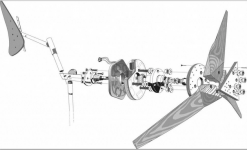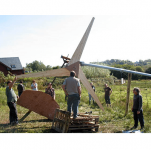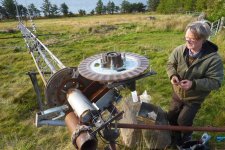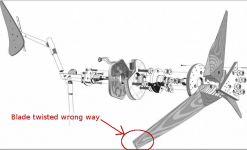Come to think of it, I dont think I was disagreeing haha.
What with the increasing numbers of hybrid electric propulsion for LNGC etc, those huge engines days are numbered, in favour of even higher efficiency of electric drive.
What with the increasing numbers of hybrid electric propulsion for LNGC etc, those huge engines days are numbered, in favour of even higher efficiency of electric drive.
Electric motors are wonderful. Batteries not so much....those huge engines days are numbered, in favour of even higher efficiency of electric drive.
Last time I checked, energy density of available lithium batteries is still basically fifty to a hundred times lower than gasoline. Since the early 2000s, I've watched as lipo batteries are improved and made more durable -and they tend to get heavier (per joule of stored energy) in the process. You need about 50 kg of battery to store the energy in 1 kg of gasoline, in other words.
What will electric container ships use to provide the electricity?
Solar? At 100 watts/square metre, it takes 10 square metres of solar panels to generate one horsepower's worth of electricity. It would take one million square metres of solar panel to power a 100,000 horsepower motor, matching the engines in these container ships. That's a square kilometre of solar panels. 😱
Actually that wouldn't be enough - there are only six to eight hours of good sunlight in a day, so to generate enough power to keep the ship running the other 16 hours a day, you'd need three square kilometres of solar panels, plus a lithium battery big enough to turn the ship into a very dangerous bomb.
Lithium battery? My co-worker's Tesla 3 needs six hours a day of being plugged into a level-one charger to charge up just enough for his 50 km round-trip commute, less than half an hour's driving each way. The little car is quite a porker at two tons, much of the weight being in the enormous battery.
A container ship runs 24 hours a day, as many days of the year as possible, and for weeks at a time during ocean crossings. Many weigh over 200,000 tons, a hundred thousand times more than the Tesla 3.
There is talk of using electric ferries to move passengers and cars between nearby islands here in BC. That might be possible, I think, though it will probably turn out to be impractical and uneconomic.
But I will go out and buy a hat, and then eat it, if we see an entirely electric container ship in the 200,000 tonne class capable of travelling from China to North America entirely on electric power, without burning any fuel to power its engines. I do not believe this is anywhere close to being possible.
In case of misunderstanding: no, I have nothing against electric power. Yes, I want the world to get off fossil fuels as quickly as possible. No, I don't think our batteries are even remotely close to being able to replace fossil fuel in many applications.
-Gnobuddy
I guess nobody bothered to read my link, which explained everything happening regarding emissions and fuel efficiency in shipping.
Also, the "technology has hit a wall in situation x" argument is not really relevant. If you have worked in R&D, you know that many of the "walls" are just the result of inaction on the part of industry and government; if you don't incentize with fiscal reward or regulation, technology development will not happen.
Also, the "technology has hit a wall in situation x" argument is not really relevant. If you have worked in R&D, you know that many of the "walls" are just the result of inaction on the part of industry and government; if you don't incentize with fiscal reward or regulation, technology development will not happen.
Come to think of it, I dont think I was disagreeing haha.
What with the increasing numbers of hybrid electric propulsion for LNGC etc, those huge engines days are numbered, in favour of even higher efficiency of electric drive.
As in Diesel Electric drive, Turbine Electric drive, etc?
Or battery- Electric motor powered?
I did the control firmware/hardware, lng, cng, lpg, turbine mech drive, turbine-electric, diesel ic, combined cycle etc.
It's an interesting field. Each application has a different solution.
Weight, complexity, purchase cost, operating cost and emissions are factors.
It's an interesting field. Each application has a different solution.
Weight, complexity, purchase cost, operating cost and emissions are factors.
Would love to see your work; in all my years of planning, I've never seen a tornado diagram on sensitivity to conspiracy theories 😀
I attended a power/utility/transmission line conference few years back.
My project at that time was grid powered shale well completions.
Can you believe one session addressed remaining a viable business during total calamity?
Ie reserve funds required if dollar collapses/devalued, retaining skilled workforce and estimated labor costs in a 10/1 devaluation.
Ten years ago all of such talk was considered 'conspiracy theory'.
My project at that time was grid powered shale well completions.
Can you believe one session addressed remaining a viable business during total calamity?
Ie reserve funds required if dollar collapses/devalued, retaining skilled workforce and estimated labor costs in a 10/1 devaluation.
Ten years ago all of such talk was considered 'conspiracy theory'.
Not really, in a big, smart company they will do strategic scenario planning for a lot of wild scenarios. Research shows that the best leaders actually will be ahead of and make important decisions before a disruption happens.
People used to wait a year for their goods (spices, etc) to arrive by sailing ship (round-trip time), and they cost a fortune - they were only for the wealthy. Now we want our "stuff" in a couple of days, and we want it cheaply enough so people struggling along on minimum wage can still buy it.Cargo in WW1 sailed.
We could make faster and stronger sailing ships now, if we wanted to, with modern materials and maybe solar / electric assist for windless days. But they would still be very slow, very unreliable, and certainly wouldn't come close to matching container-ship speeds or cargo capacity. One or two hundred-thousand tonnes of cargo ploughing through the water at 24 knots. 😱
Those huge cargo ships are a pretty amazing feat of engineering. Almost a practical demonstration of the ancient "Irresistible force meets immovable object" philosopher's paradox. All so that you and I can buy $1.25 rubber duckies made in China.
We have plenty of jellyfish now, in our ruined, overheated, CO2-filled oceans. Maybe we could harness them to pull future cargo ships? It'd be better than being becalmed for weeks when the winds stop. 😀
-Gnobuddy
I wonder if you could use windmills on a ship to generate enough power to charge the batteries to move the ship at 9 knots? That's about when the windmills start to generate if there is no head wind.
What about a head wind, increasing the turbine speed. Perhaps use prevailing winds in one direction and back-up diesel power for part of the return trip? If the following winds are strong enough, then that point is moot.
What about using the towers as a mast and augmenting the turbine with sails?
What about adding solar panels on deck to again augment?
Sounds expensive but I wonder if it could work from a principal.
What about a head wind, increasing the turbine speed. Perhaps use prevailing winds in one direction and back-up diesel power for part of the return trip? If the following winds are strong enough, then that point is moot.
What about using the towers as a mast and augmenting the turbine with sails?
What about adding solar panels on deck to again augment?
Sounds expensive but I wonder if it could work from a principal.
Last edited:
DARPA started a project for "miniature nuclear reactors" with a possible commercial end product as well as military use. While complex and risky at first they could be a viable alternative for container ships. The Pentagon wants mobile nuclear reactors for FOBs, but some scientists say that’s ‘naive’
I was thinking about this earlier today. The numbers are not optimistic.What about adding solar panels on deck to again augment?
Apparently the bigger container ships are roughly 400 metres long and 32 metres wide. If you covered the entire deck with solar panels (which you can't, because containers are piled high everywhere), you'd have 12,800 square metres of solar panels, equivalent to about 1280 kilowatts of electricity at noon in bright sunshine on the equator with typical 10% efficient solar panels. There are slightly more efficient panels available, but costs soar rapidly.
Meantime, that big cruise-ship engine I linked to earlier makes 70,000 kilowatts of power, or about 55 times as much power as those solar panels can generate.
Put another way, covering the entire deck with solar panels would, on a sunny day at the equator, generate less than two percent of the energy needed to match today's container ship engines. 🙁
The fact is, solar power at the earth's surface is extraordinarily weak as an energy source. Evolution has been working on extracting energy from it for about three billion years, and evolution is an excellent engineer. But we still don't see whale-sized, or rhino-sized, or even kitten-sized solar-powered animals running around - evolution never managed to create those, because there isn't enough energy in sunlight to make it happen. Trees and plants stay in one place, and take years to muster enough energy to raise their own weight up from the ground as they grow upwards.
We humans have managed to separate solar collection and solar energy use, so we can lay out a square kilometre of solar panels in the desert, pipe the power somewhere else, and run a few Teslas with it. The Tesla doesn't have to carry enough solar panels to power itself, so it's able to move.
But a container ship? You can't run wires to it, with the solar array on land. It has to carry its own solar panels, just like every green plant and tree on earth does. So it's burdened with the same terrific shortage of energy that plants have to deal with. Plants don't run around, and neither will a solar-powered ship. 🙁
Incidentally, I found out that there are at least three solar-powered animals known to science. All three have incorporated green algae into their own body tissue, and it is the green algae that use solar power to manufacture food the animals live on. All are small and light, and NONE of them is very active, though they move more than plants do:
1) Firstly, golden jellyfish, in Palau's Jellyfish Lake, which capture just enough energy from the sun to track it in its arc across the sky, swimming slowly across the lake to follow the sunlight every day: (
Golden Jellyfish | National Geographic )
2) Secondly, a type of marine flatworm. They spend their days lying in shallow water, getting just enough energy from the sun to stay alive and inactive: https://www.accuweather.com/en/weather-news/bizarre-solar-powered-worms-are-social-sunbathers/373142
3) Solar-powered sea slugs (on the brink of extinction): Solar-Powered Sea Slugs Becoming Too Rare to Study
-Gnobuddy
I wonder if you could use windmills on a ship to generate enough power to charge the batteries to move the ship at 9 knots? That's about when the windmills start to generate if there is no head wind.
What about a head wind, increasing the turbine speed. Perhaps use prevailing winds in one direction and back-up diesel power for part of the return trip? If the following winds are strong enough, then that point is moot.
What about using the towers as a mast and augmenting the turbine with sails?
What about adding solar panels on deck to again augment?
Sounds expensive but I wonder if it could work from a principal.
Ok these are not for a ship but I'm throwing this out there cause I know this is a diy crowd. These are DIY plans for a homebrew wind turbine. I've made one of these but I now live in an apartment so I can't use it. But the reason I bring that up is to point out that it's very easy to do. The plans come from a guy who lives in Scotland, Hugh Piggott.
All of the books by Hugh (how to get them) | Hugh Piggott's blog
Attachments
The turbine blades are shown twisted in the wrong direction!These are DIY plans for a homebrew wind turbine.
As shown in those plans, the blade will try to move towards the sharp trailing edge of the aerofoil, not the blunt leading edge. Efficiency will be very poor; all the hard work of carving the aerofoil section will be useless.
The second image below shows the correct direction of twist.
Mr. Piggott seems to know what he's doing, so this must be a case of bad proof-reading of those plans.
-Gnobuddy
Attachments
Are you sure?....... ...... ......
HP per CI....... ...... ......
HP/CI is NOT any sort of "constant". It obeys the obvious laws of scaling. You can run engine plans through a Xerox set for 50% or 200% linear scale and closely predict HP/CI, HP/lb, etc.
The thumb-engines run to the low end of the scale because they are simplified compared to real engines.
Yes, life matters. Traditionally a long-life engine was worked at low piston speed. See the bad scan's ship-engine. Probably made to stand total neglect for decades. The high piston speed of the new cargo-ship engine is a surprise; but as said they do plan to do considerable maintenance at sea, even pulling pistons out. Maybe the improvement in HP/lb, and Payload, and possibly HP/$, justifies a lot of mechanics and tools on board.
Gnobuddy,
Yep batteries are poor, which is why many Liquid Natural Gas Carriers are switching to electric propulsion, supported by on board generation (gas turbine or diesel sets). Also cruise liners. I'm not aware if cargo ships are going hybrid yet, but if LNGCs are, they I'd bet that cargo in general is moving that way.
Submarines, both Nuke and diesel plus battery, have used electric propulsion for decades.
Its interesting that a few MegaWatts of propulsion can be the size of a small car, and yet the power source, whether battery, reactor, or turbine, are many times larger. Something like a Wärtsilä diesel, typical of marine applications, is probably 5 times the size, if not more, than the small city scale electric generator (10-20MW) that is used on board to supply the need of several thousand cruise passengers, and ship operations.
Going further, an electric propulsion motor of 10-20MW, is also probably one fifth the size of a marine diesel.
If you like, the electric device power density (turbine, Motor or Generator), has increased disproportionately with the improvement in power generation power density (furnace, reactor), but whatever is done in tech, fundamental limitations exist in the physical world, such as the transportation of energy of one kind or another. Be it water/steam in nuclear, hydro, coal there are limits to efficiency of the transducer- fluid dynamics, thermodynamics, and other subjects i know nothing about!
"X amount of water can only carry Y amount of energy, at Z rate, and then give it up with W% efficiency."
What I do know and understand better, is that the electrical transducers; motors, generators are at least 95% efficient; where any real world thermodynamic engine is seldom above 50%.
Gas Turbines and nuclear reactors plus associated Steam turbines, may be a lot more efficient - if someone knows the combined efficiency of a nuclear reactor and turbine, I'd be interested to know!
Yep batteries are poor, which is why many Liquid Natural Gas Carriers are switching to electric propulsion, supported by on board generation (gas turbine or diesel sets). Also cruise liners. I'm not aware if cargo ships are going hybrid yet, but if LNGCs are, they I'd bet that cargo in general is moving that way.
Submarines, both Nuke and diesel plus battery, have used electric propulsion for decades.
Its interesting that a few MegaWatts of propulsion can be the size of a small car, and yet the power source, whether battery, reactor, or turbine, are many times larger. Something like a Wärtsilä diesel, typical of marine applications, is probably 5 times the size, if not more, than the small city scale electric generator (10-20MW) that is used on board to supply the need of several thousand cruise passengers, and ship operations.
Going further, an electric propulsion motor of 10-20MW, is also probably one fifth the size of a marine diesel.
If you like, the electric device power density (turbine, Motor or Generator), has increased disproportionately with the improvement in power generation power density (furnace, reactor), but whatever is done in tech, fundamental limitations exist in the physical world, such as the transportation of energy of one kind or another. Be it water/steam in nuclear, hydro, coal there are limits to efficiency of the transducer- fluid dynamics, thermodynamics, and other subjects i know nothing about!
"X amount of water can only carry Y amount of energy, at Z rate, and then give it up with W% efficiency."
What I do know and understand better, is that the electrical transducers; motors, generators are at least 95% efficient; where any real world thermodynamic engine is seldom above 50%.
Gas Turbines and nuclear reactors plus associated Steam turbines, may be a lot more efficient - if someone knows the combined efficiency of a nuclear reactor and turbine, I'd be interested to know!
Last edited:
PRR,
I'm probably looking too simply at it, and I'm talking from a place of almost complete ignorance.
I dont drive, own a car, or bike. I helped my flatmate change a head gasket on a MK1 Fiesta, and do the timing/points change.
Other than that I have had a few glow engines in my youth, and was shocked to learn even a basic 0.20 or 0.22 ci (1.5cc?) can easily produce 0.5hp.
Particularly, when glow engines are about as high tech as the old Mamod engine of my fathers, that I played with as a child, but capable of real power.
Even more so, when you consider the size of the motor or generator needed to turn 0.5hp at 25,000 rpm into the 0.3kW is represents.
For those interested, there is a micro generation company doing crazily cool things with small scale gensets for remote areas, in my home town.
(I'm not affiliated, but did have an job interview back when they were a start up business)
Bladon Micro Turbine
I'm probably looking too simply at it, and I'm talking from a place of almost complete ignorance.
I dont drive, own a car, or bike. I helped my flatmate change a head gasket on a MK1 Fiesta, and do the timing/points change.
Other than that I have had a few glow engines in my youth, and was shocked to learn even a basic 0.20 or 0.22 ci (1.5cc?) can easily produce 0.5hp.
Particularly, when glow engines are about as high tech as the old Mamod engine of my fathers, that I played with as a child, but capable of real power.
Even more so, when you consider the size of the motor or generator needed to turn 0.5hp at 25,000 rpm into the 0.3kW is represents.
For those interested, there is a micro generation company doing crazily cool things with small scale gensets for remote areas, in my home town.
(I'm not affiliated, but did have an job interview back when they were a start up business)
Bladon Micro Turbine
The most interesting thing about LNGC marine is that, at least to some extent, when using a hybrid gas turbine genset and electric propulsion, you can use the boil off gas for power generation.
Gas, which would I suspect be vented in the conventional case, wasted, only to add to greenhouse emission.
If you think on further, and I dont think anyone has done this yet in a vessel; you could burn that boil off gas, generate to motor the LNGC electrically, and charge batteries with excess.
Gas, which would I suspect be vented in the conventional case, wasted, only to add to greenhouse emission.
If you think on further, and I dont think anyone has done this yet in a vessel; you could burn that boil off gas, generate to motor the LNGC electrically, and charge batteries with excess.
- Home
- Member Areas
- The Lounge
- Supply chain broken?






